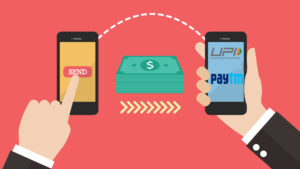
![]()
Digital Payments/ UPI
Digital payments and Unified Payments Interface (UPI) have revolutionized the way transactions are conducted in India, bringing convenience, speed, and security to financial transactions.
Overview of digital payments and UPI in India:
1. Digital Payments Landscape:
India has witnessed a significant shift towards digital payments in recent years, driven by factors such as increasing internet and smartphone penetration, government initiatives to promote digital transactions, and the rise of fintech companies offering innovative payment solutions.
2. Unified Payments Interface (UPI):
UPI is a real-time payment system developed by the National Payments Corporation of India (NPCI) that facilitates instant fund transfers between bank accounts using a mobile platform.
UPI allows users to link multiple bank accounts to a single mobile application and enables seamless peer-to-peer (P2P) and peer-to-merchant (P2M) transactions.
3. Key Features of UPI:
a). 24/7 Availability:
UPI transactions are seamlessly executable at any hour, even on weekends and holidays.
b). Instant Settlement:
Funds transferred via UPI are settled in real-time, providing immediate access to the recipient.
c). Interoperability:
UPI is interoperable across different banks and payment service providers, allowing users to transact with anyone regardless of their banking provider.
d). Secure Authentication:
UPI transactions are secured through two-factor authentication, typically involving a combination of MPIN (Mobile Personal Identification Number), biometrics, or device authentication.
e). QR Code Payments:
UPI supports QR code-based payments, enabling merchants to accept payments from customers by scanning a QR code displayed at the point of sale.
4. Popular UPI Apps:
Several mobile applications in India offer UPI-based payment services, including:
- Google Pay (formerly Tez)
- PhonePe
- Paytm
- BHIM (Bharat Interface for Money)
- Amazon Pay
- WhatsApp Pay
5. Government Initiatives to Promote Digital Payments:
a). Demonetization:
The demonetization of high-denomination currency notes in 2016 accelerated the adoption of digital payments in India.
b). Digital India:
The Digital India initiative aims to promote digital literacy and facilitate the widespread adoption of digital technologies, including digital payments, across the country.
c). Pradhan Mantri Jan-Dhan Yojana (PMJDY):
The PMJDY aims to ensure financial inclusion for all citizens by providing them with access to basic banking services, which has paved the way for increased adoption of digital payment solutions.
6. Benefits of Digital Payments and UPI:
a). Convenience:
Digital payments offer users the convenience of conducting transactions anytime, anywhere, without the need for physical cash.
b). Speed:
UPI transactions are processed in real-time, providing instant fund transfers between accounts.
c). Security:
UPI employs robust security measures to safeguard transactions, including encryption, authentication, and transaction limits.
d). Financial Inclusion:
Digital payments and UPI have played a significant role in promoting financial inclusion by providing access to banking and payment services to underserved populations.
Overall, digital payments and UPI have emerged as game-changers in India’s financial ecosystem, driving the country towards a more cashless and digitally empowered economy.
FAQ’s on Digital Payments/ UPI:
1. What is digital payment UPI?
Ans: UPI (Unified Payments Interface) is a digital payment system in India that enables seamless fund transfers between bank accounts using smartphones.
It allows users to instantly send and receive money, pay bills, and make online purchases directly from their bank accounts, without needing to enter sensitive financial information every time. UPI has gained widespread popularity because of its convenience, speed, and security.
2. Are UPI payments free?
Ans: Yes, UPI (Unified Payments Interface) payments are often free for users. However, some banks or payment service providers may impose certain charges or fees under certain circumstances, such as exceeding a certain number of transactions per month or conducting high-value transactions.
It’s always a good idea to check with your bank or payment provider for specific details on any potential charges associated with UPI transactions.
3. Disadvantages of UPI payments
Ans: Some disadvantages of UPI (Unified Payments Interface) payments include – Dependency on Internet Connectivity, Security Concerns, Transaction Limits, Compatibility Issues, Technical Glitches, Dependency on Smartphone, Transaction Fees.
Overall, while UPI offers convenience and speed in payments, users should be aware of these potential disadvantages and take necessary precautions while using the service.
4. Advantages of UPI payments
Ans: PI (Unified Payments Interface) payments offer several advantages – Convenience, 24/7 Availability, Instant Transfers, Interoperability, Security, Cost-effective, Promotes Digital Economy, Utility Bills Payment.
Overall, UPI payments offer a fast, secure, and convenient way to transfer money, contributing to the modernization of the payment ecosystem and fostering financial inclusion.
5. Are UPI payments safe?
Ans: Yes, UPI (Unified Payments Interface) payments are generally considered safe. Unified Payments Interface (UPI) is real-time payment system designed by the National Payments Corporation of India (NPCI), streamlining inter-bank transactions.
However, like any online payment system, users should still exercise caution and follow best practices for online security, such as using strong and unique passwords, keeping their devices and software updated, and being vigilant against phishing attempts or unauthorized access to their accounts.
For further details access our website: https://vibrantfinserv.com